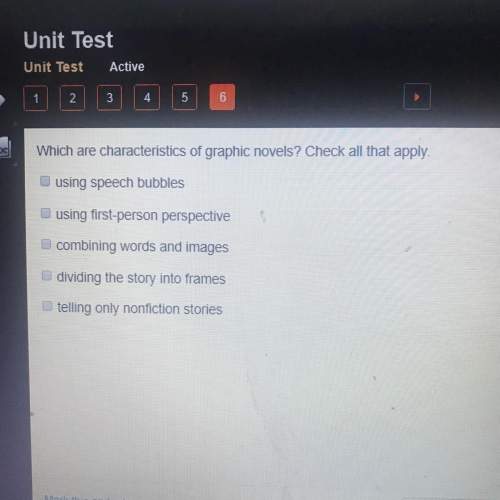
"Everyday Use.” What kind of characterization is the author using to let the reader understand what Maggie is like?
Have you ever seen a lame animal, perhaps a dog run over by some careless person rich enough to own a car, sidle up to someone who is ignorant enough to be kind to him? That is the way my Maggie walks. She has been like this, chin on chest, eyes on ground, feet in shuffle, ever since the fire that burned the other house to the ground.
Indirect characterization through the narrator’s eyes
Direct characterization through Maggie’s actions
Indirect characterization through Maggie’s physical description
Direct characterization through Maggie’s speech

Answers: 1


Other questions on the subject: English

English, 21.06.2019 15:40, jadenwilsan
The lines "original! we're all as like each other as those dolls cut out of the same folded paper. we're like patterns stencilled on a wall. can't you and i strike out for ourselves, may? " reflect which of the recurring themes of 20th and 21st century american literature?
Answers: 2

English, 21.06.2019 16:00, ladawnrowles005
Read the excerpt below and answer the question. she dwelt among the untrodden ways beside the springs of dove, a maid whom there were none to praise and very few to love: a violet by a mossy stone half hidden from the eye! --fair as a star, when only one is shining in the sky. she lived unknown, and few could know when lucy ceased to be; but she is in her grave, and, oh, the difference to me! (wordsworth, “she dwelt among the untrodden ways”) which option explains a meaning implied by the use of the adjective untrodden in the excerpt? the maid was lost in the woods. the maid lived in a rural setting. the maid was a nature spirit. the maid suffered a life without joy.
Answers: 1

English, 21.06.2019 21:40, amberskids2
4.in those days the church was not merely a thermometer that recorded the ideas and principles of popular opinion; it was a thermostat that transformed the mores of society. •type of figurative language: •meaning of figurative language: •effect on tone and mood: •effect on audience: choose out of these: hyperbole, irony, historical question, paradox, allusion, metaphor, personification, symbolism and simile
Answers: 3

English, 22.06.2019 03:40, msdmdsm7925
Match each stanza structure to the correct term. a stanza of two lines quatrain a stanza of four lines octave a stanza of six lines couplet a stanza of eight lines sestet arrowboth arrowboth arrowboth arrowboth
Answers: 3
You know the right answer?
"Everyday Use.” What kind of characterization is the author using to let the reader understand what...
Questions in other subjects:


Computers and Technology, 29.04.2021 21:20


Mathematics, 29.04.2021 21:20

Mathematics, 29.04.2021 21:20


Mathematics, 29.04.2021 21:20



Mathematics, 29.04.2021 21:20




